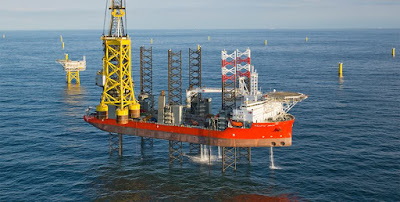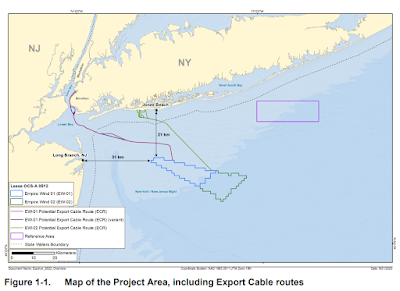Debunking the Offshore Wind farm fish barrier myth
The topic of offshore wind development in New Jersey waters has created three main groups of people: Those all for clean, responsible, and affordable renewable energy growth, those against it for any and all reasons, and the silent majority who are waiting to see regardless of the outcome, and pretty much fine with either as long as their bills don’t rise too much. I'd like to focus here on those who are against offshore wind development.
Recently, there have been some fearful concerns being raised regarding the electromagnetic fields (EMF) produced by the submarine power transmission cables.
Specifically, there is a misleading claim that the EMF of a submarine power cable will create an electromagnetic barrier that fish, namely Summer flounder (Fluke) will not cross. The contention is that this would affect their annual migration inshore from offshore wintering areas and ultimately lead to the collapse of an important fishery, which is clearly a bad thing. As a result, they demand that offshore wind farms should be halted.
As a fisherman and not an offshore wind power expert, I reached out to folks outside of the offshore wind development companies and went down the supply chain to speak with experts in the field of underwater cables and electrical engineering. This is what I found out.
We must carefully acknowledge concerns which are based on direct observation, history, facts, and studies. However, this is not one of them. This selective reporting to elicit fear and create doubt about the future of wind farms is intentional and hollow. Very few studies have been done on the effects of submarine power EMF on bottom-dwelling fish such as flounder because no significant observable impacts have ever been reported with the existing offshore wind farms or submarine power cable systems, anywhere around the world.
Had the Fisherman Magazine chosen to report on this with accuracy in its April 2019 issue they would have concluded exactly what the 2006 Danish study found as well. The study concluded that there were no definitive responses or significant negative impacts observed. Flounder continued to cross the cable but may have been observed at times to go slower across the cable during the study, but it never interrupted the fish’s travel.
It is important to note that the scientists could not conclusively attribute changes in behavior to the EMF. This can be for a host of reasons. Perhaps fish were reacting to the observation methods. Fish may have sensed a slight remnant of a cable trench (structure) or even some thermal effects of the cable. Speaking to someone who is in the industry, they personally have witnessed thousands of flatfish in the North Sea crossing submarine power cables, swimming along them, and even using the remains of the cable trench as structure to hunt and hide for prey. A cable trench sometimes remains for a time following installation depending on the bottom conditions.
The bottom line as to why EMF is extremely unlikely to cause an effect on fish behavior and or migration patterns offshore New Jersey (or elsewhere) is because modern AC submarine power cables are heavily sheathed and shielded. The sheath blocks all electric fields, although the magnetic field remains. The cables used for offshore wind farms have 3 power cores bundled together inside a common armor layer. The current in the 3 cores is phase-shifted so that the magnetic fields from the cores oppose each other and thus the external magnetic field is very low. Finally, these cables would be buried to a depth of 2-3 meters (80 to 120 inches).
Where does this concern stem from? It seems to be rooted in a misunderstanding of the technology.
If EMF or specifically the magnetic field of the cables did, in fact, block fish from migrating, then there would be no flounder currently caught inside of many estuaries, bays, tidal rivers, fjords, and seas. We have many examples of around the world where submarine power cables of all types and sizes stand between these water bodies and the open water. The fish would not move in and out to breed and we would no longer have those fish after a few years. However, there is simply no practical evidence of an EMF barrier. Fully developed large scale wind farms overseas have been in operation for many years now with no reported related issues from the fisheries.
We can conclude that people with special interests against offshore wind development, against anything for that matter, will use any argument they can to stop it, even false arguments. They will use those arguments to gain support from whomever they can, even if the issue is completely invalid, as is with this EMF case. The irony to me is this EMF concern is being raised by a recreational fishing magazine that relies on selling advertising space to marine manufacturers and tackle trades.
One would think that these guys would dive head first into this, using the publication to encourage participation in the stewardship process.
We all need to stand together and make sure that the offshore wind developers take our input during the early planning stages and site turbines correctly. We should be using our collective voice to ensure we have access to project sites and raise real potential issues early to avoid conflict in the future. It seems there is another motivation beneath all of this, to help fan the flames of opposition that we are currently seeing from the profitable and influential commercial bottom trawling fleet and from folks that want to keep the natural gas supply pumping.
Burning fewer fossil fuels leads to cleaner, healthier waters which benefit us all. More structure in the water means more fish habitat and aggregation of key gamefish species like Black Sea Bass, Summer flounder, blackfish and many more. This leads to increased fishing opportunity, increased trips out on the water with more paying customers on party boats, and more folks feeling confident enough with the fishing to buy more tackle, boats, and trucks to tow them.
 Overall, it leads to an improved and sustainable coastal economy. Looking at the long-term gains instead of short-term profits, offshore wind power could help stem the tide of rising water temperatures and help to hold our gamefish species along our shores and slow many species’ northward progression. All this while adding thousands of American jobs, sustaining our coastal economy and building the recreational fishing business!
Overall, it leads to an improved and sustainable coastal economy. Looking at the long-term gains instead of short-term profits, offshore wind power could help stem the tide of rising water temperatures and help to hold our gamefish species along our shores and slow many species’ northward progression. All this while adding thousands of American jobs, sustaining our coastal economy and building the recreational fishing business!
Kyle Kingman is an expert in high voltage submarine cable systems, installation, and protection. He has worked with numerous large energy companies and Transmission System Operators around the world including providing the lead representation of the two largest HVDC Power Interconnector projects in history, which represents a 4 Billion Euro combined investment.
Capt. Paul Eidman is an NJ based small business owner of Reel Therapy fishing charters and an advocate for fisheries conservation and habitat. He represents Anglers for Offshore Wind Power, a group that is speaking up for responsibly developed offshore wind power. AFOWP's key principles are Angler access, angler input, and science before, during and after construction.
For more info and to sign on to our principles, please visit www.anglersforoffshorewindpower.org







Comments
Post a Comment